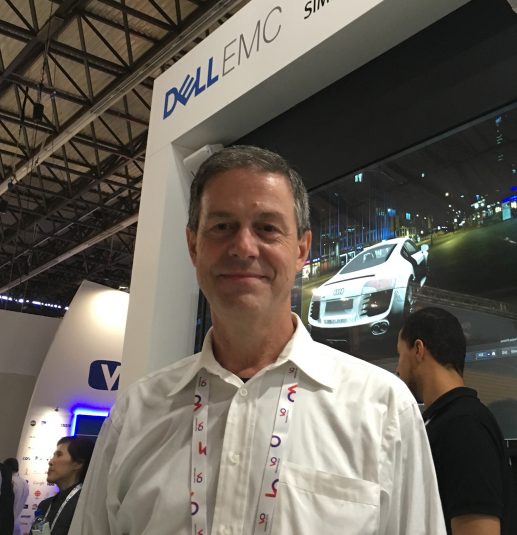IBC Q&A: Dell EMC’s Burns on how M&E customers will benefit from the Dell-EMC combo
Fresh off the official completion of Dell’s $60 billion acquisition of EMC — the largest technology merger in history — the newly dubbed Dell EMC arrived at IBC 2016 with a variety of new technologies and demos in tow. Part of Dell Technologies, Dell EMC is looking to leverage existing and new technologies from Dell, EMC, and VMWare to create new best-of-breed solutions for the media and entertainment (M&E) market.
Among the highlights are a virtualized live–channel-playout solution that combines Imagine Communications’ Versio platform with EMC’s converged VCE Vblock system and EMC’s Isilon scale-out NAS storage system, an integration of EMC Isilon storage and Rohde & Schwarz Venice ingest and production platform, integration between Isilon or ECS media repository and Avid Interplay, and full-resolution 4K workflows using EMC, Pixspan, Aspera, and NVIDIA technology (which were also showcased at NAB 2016).
SVG sat down with Dell EMC CTO, Media & Entertainment, Tom Burns to discuss the cavalcade of demos at the booth and how he expects the combination of Dell and EMC to create better products for the M&E industry.
Following Dell’s acquisition of EMC, how will the two company’s combined technology portfolio better serve the broadcast industry?
One of the things that we heard in the IABM state-of-the-Industry presentation this morning is that the media and entertainment companies are still looking for best-of-breed but in a different fashion. What we’re able to do now with the integration of Dell servers and EMC storage is essentially best-of-breed enterprise IT. By coming up with a pre-architected, pre-validated hardware and software stack and working with our partners, we can provide [solutions] that no one else can. We think that, with the combination of Dell and EMC and VMware, we are providing a best-of-breed hardware environment for all of the ISVs [independent software vendors] to run their broadcast applications on.
What are some examples of these combined best-of-breed solutions you have on display here?
We are showing a fully virtualized Imagine Versio playout solution that can run on anyone’s converged infrastructure. That is one perfect example.
One key for us this year is no vendor lock-in. In the old days, somebody like Autodesk would make a visual-effects and color-finishing workstation that had to tightly qualify on an HP workstation with a specific flavor of Linux and a specific SAN. Here at IBC, for the first time ever, we are showing Autodesk Flame running on a Dell workstation. By being able to give people their choice of infrastructure and working hard with all of the broadcast ISV partners like Imagine and the content-creation ISVs like Autodesk, we are confirming that Dell EMC is now the safe choice. You buy this infrastructure, and, if you decide to change your workload in two years, there is no vendor lock-in because it’s all containerized and virtualized.
What else are you highlighting at IBC 2016?
Another thing we’re showing is a new model of our object storage, the ECS [Elastic Cloud Storage] product line, which is even cheaper and more powerful than the original ECS object storage. It’s a really great [object storage] solution. Whether it’s on-prem or in a co-location someplace as a private cloud, it enables collaboration as well as allows these sites to be the DR for each other. That is a really integrated, best-of-breed workflow. But it’s not the old media-and-entertainment best-of-breed, where some overworked engineer would build it onsite and have to maintain it for 20 years. This is about workload mobility.
We think that our infrastructure has the best storage, the best computer, and the best networking. Now it’s being engineered and sold as a hyper-converged appliance so that customers who want to buy and get up and running right away, rather than spend a year building all the infrastructure themselves, can buy a pre-engineered hyper-converged solution right from us.
Are you seeing any major trends or customer requests in the sports-production industry these days?
One of the most interesting things we’re seeing in sports is the growth in integrated use of video and storage in arenas. For instance, the Atlanta Braves recently bought a rack of converged infrastructure to run their business for home directories, applications, surveillance video. The new Atlanta Braves Stadium is going to have a full mall and hotel complex, so they started with just looking at enterprise-IT stuff for normal business workloads plus surveillance video.
And then we talked to the people that are actually editing the games and producing content for linear, OTT, and a custom file-based highlights package [delivered] directly to the skyboxes, where people can access all the [camera] feeds. All of those video operations were added to the existing enterprise IT and surveillance workloads running on Isilon with the ability to tier to the cloud. [Video production] used to be its own world, its own little silo. Now we’re seeing cases where it’s completely integrated. If it scales really well, then if the video-production group borrows a little bit of storage that’s earmarked for surveillance and then gives it back by way of tiering it to the cloud, that’s a win-win for everybody. You don’t have to have a whole bunch of storage … if they start to go to a 4K camera or something like that.

